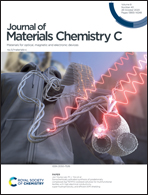Layer-dependent SERS enhancement of TiS2 prepared by simple electrochemical intercalation†
Abstract
In recent years, transition metal dichalcogenides (TMDs) have received much attention due to their excellent electrical and optical properties. TiS2 is a kind of layered transition metal dichalcogenide, and with the decrease of the number of layers, the transition from an indirect band gap to a direct band gap will occur, leading to novel electrical and optical properties. In this work, TiS2 with different numbers of layers was obtained by simplifying the electrochemical intercalation experiment and the influence of the deposition current and the number of layers on the SERS activity of TiS2 was studied. It was found that when the current was 0.25 mA cm−2, the SERS activity of TiS2 was enhanced greatly with the decrease of the number of layers. Compared with that of the layered bulk TiS2, the Raman enhancement factor of the few-layer TiS2 increased by 2 orders of magnitude to 3.18 × 105, and the detection limit to R6G was as low as 10−8 M. Such TiS2 with different layers has been developed for SERS detection and exhibits excellent SERS activity. This was mainly due to the increase in the charge transfer efficiency between the substrate and the organic molecules as the number of layers decreased. This work not only expands the application of TiS2 with few layers as an active SERS substrate, but also provides an effective method to improve the SERS activity of TMDs.



 Please wait while we load your content...
Please wait while we load your content...